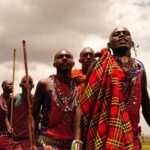In the fascinating world of insects, the Giraffe Weevil (Trachelophorus giraffa) stands out as one of nature’s most intriguing creations. With its long neck-like elongated head and distinctive appearance, the Giraffe Weevil has captured the curiosity of entomologists and nature enthusiasts worldwide. In this blog, we will delve into the extraordinary characteristics of the Giraffe Weevil, exploring its unique physical features, intriguing behavior, and the remarkable adaptations that have allowed it to thrive in the dense forests of Madagascar.
- A Long-Necked Wonder:
As the name suggests, the most distinguishing feature of the Giraffe Weevil is its elongated neck-like head, resembling that of a giraffe. The elongation in males can reach up to twice the length of their body, while females have a more proportionate head. This unique adaptation serves multiple purposes, from foraging for food to competing for mates.
- Dimorphic Display:
In Giraffe Weevils, there is a significant sexual dimorphism, meaning males and females exhibit distinct physical characteristics. While males boast the long neck, females have a shorter and thicker neck. Males also have a distinct pronotum (a plate-like structure covering the thorax) that helps them assert dominance during mating rituals.
- Habitat and Distribution:
Giraffe Weevils are endemic to the island of Madagascar, where they primarily inhabit the tropical rainforests. Their distribution is limited to the eastern rainforests of the island, where they thrive among the foliage and branches of trees.
- Feeding Behavior:
Giraffe Weevils are herbivores and feed on leaves, particularly those from the endemic fan palm known as “ravenala.” Their elongated necks allow them to access leaves high above the forest floor that other insects cannot reach.
- Life Cycle and Reproduction:
The life cycle of Giraffe Weevils involves a series of fascinating stages. After mating, females lay eggs on the soft tissues of the ravenala plant. The hatched larvae bore into the plant and feed on its tissues. As they grow, they undergo several molting stages until they pupate and eventually emerge as adults.
- Intriguing Mating Rituals:
Male Giraffe Weevils engage in elaborate mating rituals to compete for females. They use their long necks to engage in “neck fights,” pushing and jousting with other males for access to females. The male with the longest neck and most dominance wins the opportunity to mate.
- Evolutionary Marvel:
The unique physical characteristics of the Giraffe Weevil, particularly the elongated neck of males, have long puzzled scientists. It is believed that sexual selection, driven by female preference for longer-necked males, has contributed to the evolution of this extraordinary feature.
- Conservation Status:
Giraffe Weevils face various threats to their survival, primarily due to habitat destruction and deforestation in Madagascar. As the rainforests diminish, so does the habitat of these remarkable insects. Conservation efforts are essential to preserve their natural habitat and ensure the continued existence of the Giraffe Weevil.
- Captivating Curiosity:
The Giraffe Weevil is a living testament to the marvels of evolution and the incredible diversity of life on Earth. Its unique appearance and intriguing behavior continue to captivate the imaginations of researchers and nature enthusiasts, inspiring further study and conservation efforts.
Conclusion:
The Giraffe Weevil stands as a testament to the wonders of nature, showcasing the incredible diversity and adaptability of insects. Its long neck, fascinating life cycle, and elaborate mating rituals make it a captivating subject of study for scientists and nature enthusiasts alike. As we strive to understand and appreciate the biodiversity of our planet, the Giraffe Weevil serves as a reminder of the remarkable and often mysterious creatures that share our world. By protecting their natural habitats and promoting conservation, we can ensure that these unique insects continue to thrive and inspire future generations of nature lovers.




















Add Comment